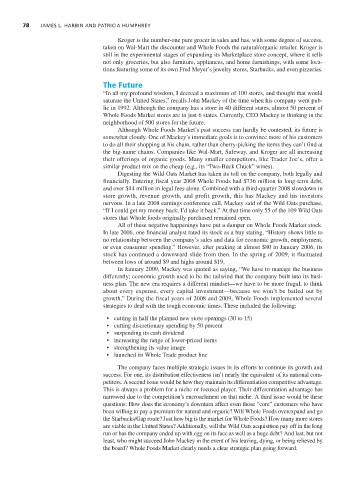Page 482 -
P. 482
78 JAMES L. HARBIN AND PATRICIA HUMPHREY
Kroger is the number-one pure grocer in sales and has, with some degree of success,
taken on Wal-Mart the discounter and Whole Foods the natural/organic retailer. Kroger is
still in the experimental stages of expanding its Marketplace store concept, where it sells
not only groceries, but also furniture, appliances, and home furnishings, with some loca-
tions featuring some of its own Fred Meyer’s jewelry stores, Starbucks, and even pizzerias.
The Future
“In all my profound wisdom, I decreed a maximum of 100 stores, and thought that would
saturate the United States,” recalls John Mackey of the time when his company went pub-
lic in 1992. Although the company has a store in 40 different states, almost 50 percent of
Whole Foods Market stores are in just 6 states. Currently, CEO Mackey is thinking in the
neighborhood of 500 stores for the future.
Although Whole Foods Market’s past success can hardly be contested, its future is
somewhat cloudy. One of Mackey’s immediate goals is to convince more of his customers
to do all their shopping at his chain, rather than cherry-picking the items they can’t find at
the big-name chains. Companies like Wal-Mart, Safeway, and Kroger are all increasing
their offerings of organic goods. Many smaller competitors, like Trader Joe’s, offer a
similar product mix on the cheap (e.g., its “Two-Buck Chuck” wines).
Digesting the Wild Oats Market has taken its toll on the company, both legally and
financially. Entering fiscal year 2008 Whole Foods had $736 million in long-term debt,
and over $14 million in legal fees alone. Combined with a third-quarter 2008 slowdown in
store growth, revenue growth, and profit growth, this has Mackey and his investors
nervous. In a late 2008 earnings conference call, Mackey said of the Wild Oats purchase,
“If I could get my money back, I’d take it back.” At that time only 55 of the 109 Wild Oats
stores that Whole foods originally purchased remained open.
All of these negative happenings have put a damper on Whole Foods Market stock.
In late 2006, one financial analyst rated its stock as a buy stating, “History shows little to
no relationship between the company’s sales and data for economic growth, employment,
or even consumer spending.” However, after peaking at almost $80 in January 2006, its
stock has continued a downward slide from then. In the spring of 2009, it fluctuated
between lows of around $9 and highs around $19.
In January 2009, Mackey was quoted as saying, “We have to manage the business
differently; economic growth used to be the tailwind that the company built into its busi-
ness plan. The new era requires a different mindset––we have to be more frugal, to think
about every expense, every capital investment––because we won’t be bailed out by
growth.” During the fiscal years of 2008 and 2009, Whole Foods implemented several
strategies to deal with the tough economic times. These included the following:
• cutting in half the planned new store openings (30 to 15)
• cutting discretionary spending by 50 percent
• suspending its cash dividend
• increasing the range of lower-priced items
• strengthening its value image
• launched its Whole Trade product line
The company faces multiple strategic issues in its efforts to continue its growth and
success. For one, its distribution effectiveness isn’t nearly the equivalent of its national com-
petitors. A second issue would be how they maintain its differentiation competitive advantage.
This is always a problem for a niche or focused player. Their differentiation advantage has
narrowed due to the competition’s encroachment on that niche. A third issue would be these
questions: How does the economy’s downturn affect even those “core” customers who have
been willing to pay a premium for natural and organic? Will Whole Foods overexpand and go
the Starbucks/Gap route? Just how big is the market for Whole Foods? How many more stores
are viable in the United States? Additionally, will the Wild Oats acquisition pay off in the long
run or has the company ended up with egg on its face as well as a huge debt? And last, but not
least, who might succeed John Mackey in the event of his leaving, dying, or being relieved by
the board? Whole Foods Market clearly needs a clear strategic plan going forward.

